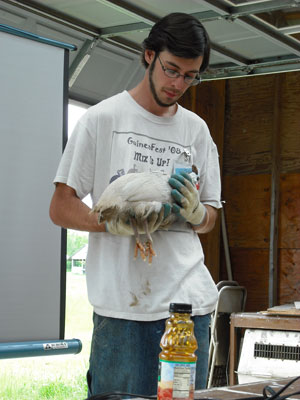 |
| Dana Manchester of Shady Hollow Farm in Morrill, Maine, talks about guinea fowl at MOFGA events. Photo copyright Shady Hollow Farm. |
By Jean English
The Small Farm Field Day held at MOFGA’s Common Ground Education Center in Unity in late May offered a wealth of information and inspiration for those who want to raise fowl.
In an amusing and informative presentation, Dana Manchester of Shady Hollow Farm in Morrill (www.shadyhollowfarm.com/) described the care and behavior of guinea fowl, a term that includes guinea hens (the egg layers), cocks (adult males), pullets (young females) and cockerels (young males). Shady Hollow Farm raises the widest assortment of guinea fowl in the United States.
These African natives are especially valuable in Maine and elsewhere now, as they use their sharp beaks to eat seeds, tiny insects and ticks, and, said Manchester, they range farther than chickens do. “It is true that they do a good job on ticks,” he said.
“They love millet seed,” he added. “Give them wild bird seed or millet as a treat. For some reason, they love little things – black flies, mosquitoes.”
Shady Hollow sells more than 60 varieties of guinea fowl – more than any other hatchery in the world, said Manchester. The adults eat chicken layer pellets. “If you feed them at the same time every evening, they will come back to the coop at night,” he added. “They get to know the sound of the door closing, of the coffee can containing their food.”
They are simple to care for and “are probably the most cold and heat tolerant bird in our climate,” Manchester continued.
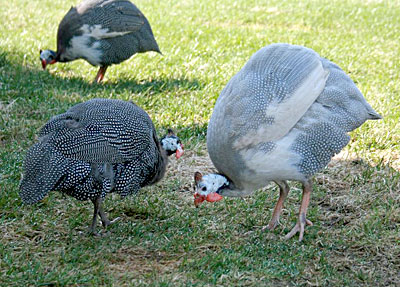 |
| Guinea fowl on the prowl for ticks and other small things. Photo copyright by Shady Hollow Farm. |
When a potential predator is nearby, the males make a loud alarm call. “They will certainly try to hold their own against predators,” said Manchester. These alarm calls could be irritating to someone raising guinea fowl or to neighbors. Manchester said the birds calm down and are quieter when they get older, and that restricting their view might help keep them quieter. Females make a quieter sound, but they make it almost continuously throughout the day.
Hens don’t build nests but scratch a depression in the sand and lay their eggs there communally – i.e., all the hens in a flock lay in that one depression. “They don’t let you collect eggs as easily as chickens do when they’ve gone broody,” said Manchester (i.e., when they’re incubating eggs). Once you do collect them, however, they’re safe while en route to your kitchen because of their tough shells. Manchester lobbed a guinea hen egg a good 20 feet in the air and let it land on the lawn several times without breaking it. This hard shell probably offers protection from snakes and mongooses in guinea fowl’s native Africa.
In fact, if you have chickens that are pecking at their own eggs, Manchester suggested putting guinea hen eggs in the chickens’ nests. The chickens “won’t be able to crack the eggs; they’ll get bored and will give up.”
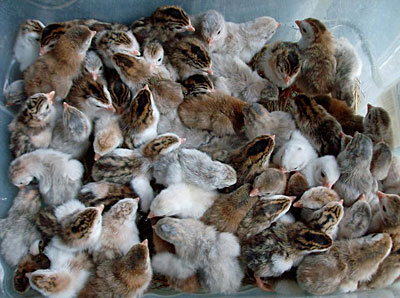 |
| Young guinea fowl, also called keets. Photo copyright by Shady Hollow Farm. |
Guinea hens will lay eggs year-round if they have supplemental light when the daylength shortens. The eggs have thick yolks and are great for scrambling, said Manchester.
Guinea fowl meat is darker than that of chickens, and it’s oilier but not gamey like pheasant meat. They have a higher percentage of meat to body weight than chickens do. It takes about 5 or 6 months to raise a good meat bird, said Manchester.
Guinea fowl live for seven or eight years. Manchester said that three to six birds would be a good number for a 1-acre site.
You can house guinea fowl with chickens, turkeys, pheasants, peafowl and geese, said Manchester. In fact, they offer good protection to broilers and turkeys.
While guinea fowl are very cold hardy, he said to keep the wind off them in winter, make sure snow doesn’t cover them, and break up any ice that forms on their water supply.
For more information about raising guinea fowl and other game birds, see Shady Hollow’s website, and Dana Manchester’s article on the subject at www.backyardpoultrymag.com/issues/2/2-2/Dana_Manchester.html.
Manchester will also be speaking about poultry at the Common Ground Country Fair. Please see the schedule of events in this issue of The MOF&G for times and places.
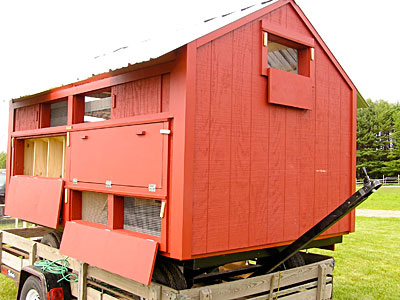 |
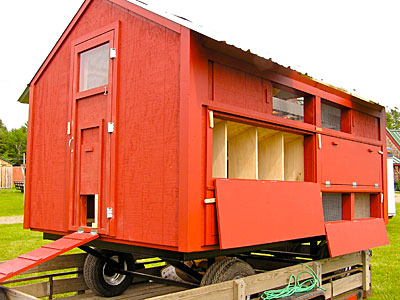 |
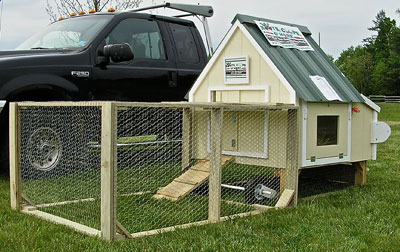 |
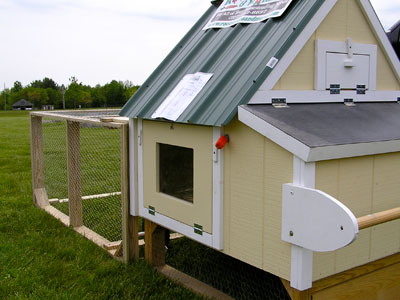 |
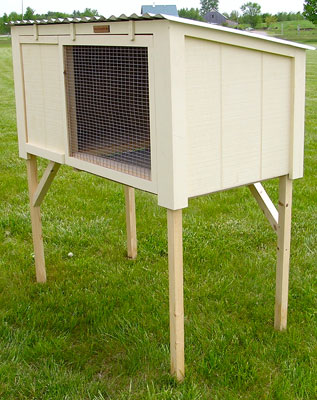 |
Portable chicken coops and a rabbit hutch made by Roots, Coops, & More and displayed at Small Farm Field Day. English photos. |
Visitors at Small Farm Field Day could see some beautiful poultry houses, too, as Roots, Coops, & More of Augusta (www.rootscoopsandmore.com) displayed its moveable pens and coops there. Their well designed coops make feeding, cleaning and egg collecting as simple as possible. For more photos of these structures and the company’s cold frames, rabbit hutch and raised bed garden frames, see the Roots, Coops, & More website.
